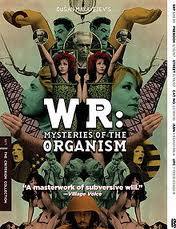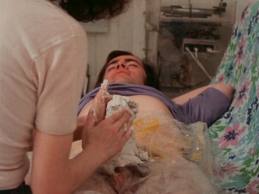W.R.: Mysteries of the Organism: Difference between revisions
No edit summary |
No edit summary |
||
| Line 18: | Line 18: | ||
'''Description of Artwork:''' The W.R. in ''W.R.: Mysteries of the Organism'' stands both for World Revolution and for Wilhelm Reich, who the film starts with a documentary about. Reich was a Marxist who believed in free love. The use of this footage is to make statements on social and sexual liberation, totalitarianism, and free love in a communist atmosphere. Later in the film one of the characters declares, "Communism without free love is a wake in a graveyard." <P> | '''Description of Artwork:''' The W.R. in ''W.R.: Mysteries of the Organism'' stands both for World Revolution and for Wilhelm Reich, who the film starts with a documentary about. Reich was a Marxist who believed in free love. The use of this footage is to make statements on social and sexual liberation, totalitarianism, and free love in a communist atmosphere. Later in the film one of the characters declares, "Communism without free love is a wake in a graveyard." <P> | ||
It also contains scenes of nudity and explicate sexuality weaved in with documentary footage of communism. As a whole, ''W.R.'' is a critique of communist sexual repression. It is not a sex film, but rather a film about sex. <P> | It also contains scenes of nudity and explicate sexuality weaved in with documentary footage of communism. As a whole, ''W.R.'' is a critique of communist sexual repression. It is not a sex film, but rather a film about sex. <P> | ||
[[File:mysteries.jpg|left]] | |||
'''The Incident:''' ''W.R.'' was shown at Yugoslav film festivals, but not released further due to Soviet pressure. The graphic sex was the biggest concern of the Ministry of Culture. Even President Josip Broz Tito had left during a screening of the film, calling it perverted. It also caused an uproar from concerned citizens. In 1973, a veteran's association who had been offended by the masturbation and homosexuality brought up a lawsuit against Makavejev. <P> | '''The Incident:''' ''W.R.'' was shown at Yugoslav film festivals, but not released further due to Soviet pressure. The graphic sex was the biggest concern of the Ministry of Culture. Even President Josip Broz Tito had left during a screening of the film, calling it perverted. It also caused an uproar from concerned citizens. In 1973, a veteran's association who had been offended by the masturbation and homosexuality brought up a lawsuit against Makavejev. <P> | ||
Revision as of 23:45, 6 December 2011
Date: 1973
Region: Russia and Central Asia
Subject: Explicit Sexuality Nudity Political/Economic/Social Opinion
Medium: Film Video
Artist: Dusan Makavejev
Confronting Bodies: Yugoslav Ministry of Culture
Date of Action: 1973
Location: Yugoslavia
Description of Artwork: The W.R. in W.R.: Mysteries of the Organism stands both for World Revolution and for Wilhelm Reich, who the film starts with a documentary about. Reich was a Marxist who believed in free love. The use of this footage is to make statements on social and sexual liberation, totalitarianism, and free love in a communist atmosphere. Later in the film one of the characters declares, "Communism without free love is a wake in a graveyard."
It also contains scenes of nudity and explicate sexuality weaved in with documentary footage of communism. As a whole, W.R. is a critique of communist sexual repression. It is not a sex film, but rather a film about sex.
The Incident: W.R. was shown at Yugoslav film festivals, but not released further due to Soviet pressure. The graphic sex was the biggest concern of the Ministry of Culture. Even President Josip Broz Tito had left during a screening of the film, calling it perverted. It also caused an uproar from concerned citizens. In 1973, a veteran's association who had been offended by the masturbation and homosexuality brought up a lawsuit against Makavejev.
Results of Incident: The film was shelved by the Ministry of Culture and Makavejev was exiled until 1988. W.R. was shown in the West, but even there, the sexuality found objections and was cut.
Source: Censorship: A World Encyclopedia. Ed. Derek Jones. Chicago; London: Fitzroy Dearborn, 2001.

